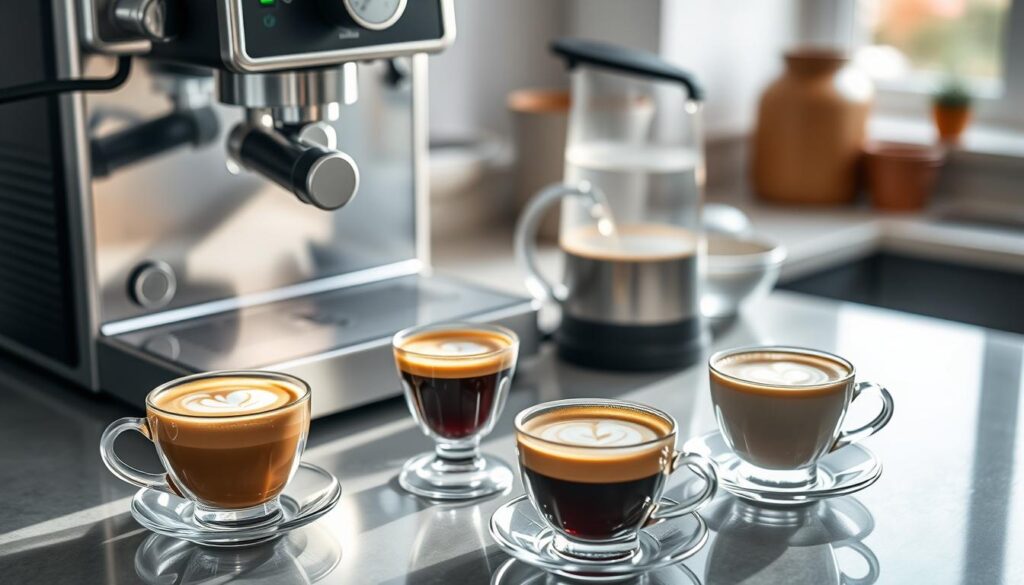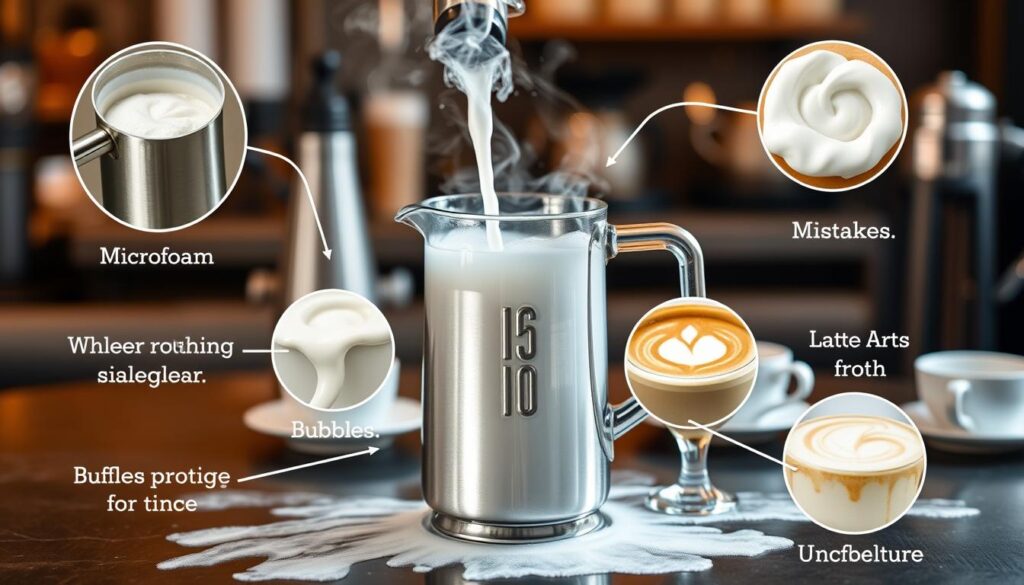Welcome to the ultimate journey into milk frothing techniques for coffee lovers! Whether you’re starting out as a home barista or looking to improve your coffee skills, this guide will change your latte making game. It will take your experience from good to great.
Making the perfect latte is an art that needs precision, skill, and love. With the right knowledge and tools, anyone can make cafe-quality drinks at home. It’s all about mastering the craft.
Milk frothing is more than just making foam. It’s about understanding the science of texture, temperature, and technique. Our guide will show you how to create silky, smooth microfoam. This turns a simple coffee into a luxurious treat.
Key Takeaways
- Learn professional milk frothing techniques
- Understand the science behind perfect foam
- Master equipment selection and usage
- Discover tips from professional baristas
- Transform home coffee brewing skills
Understanding the Science Behind Milk Frothing
Milk frothing is a delicate art that involves complex milk chemistry. The magic of creating perfect foam comes from knowing how milk proteins, fat, and temperature interact. When you prepare a latte, you’re doing a scientific experiment in your coffee cup.
Protein Structure and Temperature Effects
Milk proteins are key in making foam. Casein and whey proteins decide how good the froth will be. Heating milk makes these proteins unfold and form a stable network that holds air bubbles. The best milk temperature is between 140-160°F, which helps proteins denature without burning.
- Casein proteins provide structural stability
- Whey proteins contribute to foam elasticity
- Temperature impacts protein behavior
Different Types of Milk and Their Frothing Properties
Not all milk froths the same. Whole milk, with more fat, makes rich and creamy foam. Skim milk, with less fat, makes bigger but less stable bubbles. The type of milk affects its frothing ability.
The Role of Fat Content in Foam Creation
Fat molecules are crucial in milk frothing. They keep air bubbles stable and make foam smoother and more luxurious. Milk fat adds thickness and keeps the foam structure. Baristas often choose whole milk for its better frothing, making coffee more indulgent.
“Understanding milk’s molecular dance is the first step to creating perfect foam” – Coffee Science Experts
Essential Equipment for Perfect Milk Frothing
Making the perfect latte is more than just skill. It needs the right tools. The right milk frother, steam wand, thermometer, and frothing pitcher can make your coffee experience better.

Professional baristas know quality tools are key for great coffee. Here’s what every coffee lover needs:
- Milk Frother: Your main tool for smooth, creamy foam
- Steam Wand: Precise for heating and texturing milk
- Thermometer: Essential for the perfect milk temperature
- Frothing Pitcher: Best for handling milk
When picking a milk frother, think about these important points:
| Type of Frother | Best For | Skill Level |
|---|---|---|
| Manual Handheld | Budget-conscious beginners | Beginner |
| Electric Frother | Consistent results | Intermediate |
| Espresso Machine Steam Wand | Professional-level frothing | Advanced |
“The right equipment can elevate your coffee from good to extraordinary.” – Professional Barista Wisdom
Get a good stainless steel frothing pitcher with marks. Precision is key for perfect latte art and tasty drinks.
A digital thermometer is crucial. It keeps the milk between 140-160°F. This prevents scalded milk and keeps the espresso flavor.
The Ultimate Guide to Frothing Milk for Lattes
Making the perfect latte is all about mastering milk steaming. Whether you’re brewing at home or dreaming of being a coffee pro, learning about milk frothing is key. It can take your coffee from good to great.

Proper Temperature Control Techniques
Temperature is crucial for a great latte. The milk should be steamed between 140-160°F (60-70°C). If it gets hotter, it can burn and lose its sweetness.
- Use a digital thermometer for precise temperature tracking
- Stop steaming when milk reaches 140°F for optimal sweetness
- Listen for a subtle “chirping” sound indicating perfect temperature
Wand Positioning and Movement
Getting the steam wand right is essential. Hold it at a 45-degree angle, just under the milk’s surface. Move it in circles to make smooth microfoam.
“The secret to perfect microfoam is patience and practice” – Professional Barista Tip
Creating Microfoam vs. Dry Foam
Knowing the difference between microfoam and dry foam is important. Microfoam has tiny bubbles for a silky texture. Dry foam has bigger bubbles.
- Microfoam: Smooth, glossy texture with tiny bubbles
- Dry Foam: Large, less consistent bubble structure
- Best use for microfoam: Latte art and smooth espresso drinks
With these tips, you’ll improve your milk steaming. Soon, you’ll be making top-notch lattes at home.
Common Milk Frothing Mistakes to Avoid
Milk frothing might seem simple, but even experienced home baristas can face challenges. Knowing common frothing errors helps you make perfect milk for your favorite coffee drinks.

One big mistake is overheating milk. When milk gets too hot, above 140°F, proteins break down. This causes milk scorching and ruins its sweet flavor.
- Inconsistent foam can result from incorrect steam wand technique
- Milk temperature plays a crucial role in achieving smooth microfoam
- Positioning of the steam wand impacts overall milk texture
To avoid frothing errors, pay close attention to a few key factors:
| Mistake | Solution |
|---|---|
| Overheating milk | Use a thermometer, stop at 140°F |
| Inconsistent foam | Maintain steady steam wand angle |
| Milk scorching | Remove milk from heat immediately |
“Perfect milk frothing is an art that requires practice and precision.” – Professional Barista Tip
Pro tip: Always start with cold milk and a clean steam wand for the best frothing results.
Alternative Milk Options and Their Frothing Techniques
Plant-based milks have changed the coffee world, offering new choices for those who love vegan lattes. As more people choose non-dairy milk, it’s key to know how to froth each type well. This ensures perfect drinks every time.
To make a tasty vegan latte, you need to know how to froth different milks. Each milk type has its own way of frothing, affecting the drink’s foam and feel.
Oat Milk Frothing Guide
Oat milk is a top choice for frothing. It makes great foam that’s creamy and smooth. For the best results, use cold oat milk and steam it at 140-150°F.
- Best temperature range: 140-150°F
- Ideal for creating microfoam
- Smooth, consistent texture
Almond and Soy Milk Tips
Almond and soy milks are a bit tricky to froth. But with the right technique, you can get great foam.
| Milk Type | Frothing Difficulty | Best Technique |
|---|---|---|
| Almond Milk | Moderate | Low heat, gentle steaming |
| Soy Milk | Easy | Quick, high-temperature steam |
Coconut Milk Frothing Secrets
Coconut milk adds a rich, tropical flavor to frothing. Pro tip: Use barista-specific coconut milk for the best foam. These blends have special ingredients that help the foam last longer.
“Mastering plant-based milk frothing is an art that requires patience and practice.” – Professional Barista
Learning about each milk’s special traits will make your vegan lattes even better. It turns home brewing into a fun and tasty hobby.
Advanced Latte Art Techniques Using Frothed Milk
Latte art is more than just pouring milk. It’s a skill that turns coffee into a visual feast. Baristas use their talents to make every cup a masterpiece, pleasing customers and enhancing the coffee experience.

To excel in latte art, you need precision and lots of practice. The secret to amazing designs is knowing how to froth milk and pour it smoothly.
- Start with perfectly steamed microfoam
- Control milk temperature between 140-160°F
- Use a consistent pouring angle
- Practice steady hand movements
For beginners, professional baristas suggest a few classic designs:
| Design | Difficulty Level | Skill Required |
|---|---|---|
| Heart Design | Beginner | Basic pouring technique |
| Rosetta Pattern | Intermediate | Controlled milk flow |
| Swan Design | Advanced | Precise wrist movement |
“Latte art is about creating beauty in a cup, transforming a simple beverage into an artistic expression.” – Professional Barista Trainer
Advanced techniques involve understanding milk’s viscosity, pour speed, and cup angle. Developing muscle memory through consistent practice helps baristas craft intricate and beautiful coffee art.
Troubleshooting Your Milk Frothing Process
Milk frothing can be tricky, even for coffee lovers. To make perfect foam, you need to solve common problems. These issues can affect your drink’s quality.
Fixing Bubble Size Issues
Getting the right foam quality means controlling bubble size. Big, uneven bubbles can mess up your latte or cappuccino’s texture.
- Start with cold milk for better protein structure
- Position the steam wand at a 45-degree angle
- Keep the wand tip just below the milk’s surface
- Use gentle, consistent motion to create microfoam
Temperature-Related Problems
Wrong temperature can mess up foam quality and taste. The best milk frothing temperature is between 140-160°F.
| Temperature Range | Foam Outcome | Recommended Action |
|---|---|---|
| Below 135°F | Flat, weak foam | Increase steam time |
| Above 165°F | Burnt taste, broken protein structure | Reduce steam exposure |
Equipment Maintenance Tips
Keeping your frother in good shape is key for great milk frothing. Regular cleaning stops residue buildup and keeps it working well.
- Clean steam wand immediately after each use
- Wipe with a damp cloth
- Purge steam wand to remove milk residue
- Deep clean weekly with specialized cleaning solutions
“A well-maintained frother is the secret to professional-quality milk foam.” – Barista Pro Magazine
By fixing these common frothing issues and keeping your equipment clean, you’ll make drinks like a pro at home.
Professional Barista Secrets for Perfect Foam
Making a perfect latte is more than basic skills. Professional baristas have expert tips to turn ordinary milk frothing into art. They know the secret to creating top-notch coffee shop quality foam.
“Great milk foam is the soul of an amazing latte – it’s about precision, technique, and passion.”
Professional baristas share key techniques for better milk texture:
- Start with cold, fresh milk from the fridge
- Use a clean, cold pitcher for the best foam
- Position the steam wand at a 45-degree angle for even texture
- Listen for a subtle “chirping” sound during frothing
The secret to expert milk frothing is knowing about milk’s protein and temperature sensitivity. Pros say milk starts to break down at temperatures over 140°F. This ruins its sweet taste and smooth texture.
For latte perfection, follow these steps:
- Purge the steam wand before and after each use
- Tap and swirl the milk pitcher to break big bubbles
- Practice consistent wand depth and angle
- Focus on creating silky microfoam
By learning these professional barista techniques, you can make your home coffee taste like a cafe. You’ll create lattes that are as good as those in top coffee shops.
Conclusion
Milk frothing is an art that makes coffee special. It starts with knowing the science of milk and how to froth it. Every time you practice, you get better at making lattes like a pro.
Learning to make lattes takes time, patience, and a love for trying new things. You’ve learned about milk proteins and how to use steam wands. These skills make you stand out, whether you’re a pro or just starting.
Success as a home barista is about getting better with each try. Spend time honing your skills, trying different milks, and learning about temperature and technique. Your hard work will show in every latte you make.
Great coffee is a mix of science, skill, and creativity. You can use a fancy espresso machine or a simple frother. With each cup, your skills will grow. Keep exploring and enjoy the journey of becoming a coffee expert at home.
FAQ
What temperature is best for frothing milk?
The best temperature for frothing milk is between 140-160°F (60-71°C). This ensures the perfect texture without burning the milk or losing its sweetness.
Can I froth non-dairy milk for lattes?
Yes, you can froth non-dairy milks like oat, almond, and soy milk. But, each type needs a slightly different method. Barista-style versions froth better because of added stabilizers.
What type of milk creates the best foam?
Whole milk with 3.5% fat content makes the best foam. Its protein and fat create a rich, velvety microfoam perfect for latte art.
Do I need an expensive steam wand to froth milk?
No, you don’t need an expensive steam wand. Home baristas can use handheld frothers, electric milk frothers, or even a French press to froth milk.
How do I prevent large bubbles when frothing?
Start by placing the steam wand just below the milk’s surface. Create a gentle whirlpool motion. Tap the pitcher and swirl to break down large bubbles.
What’s the difference between microfoam and dry foam?
Microfoam is smooth and silky, with tiny bubbles perfect for latte art. Dry foam is thicker, with larger bubbles, often used for cappuccinos.
How can I tell if my milk is perfectly frothed?
Perfectly frothed milk looks glossy and has a paint-like consistency. When tilted, the foam should move smoothly without large bubbles separating.
Can I froth cold milk?
While warm milk is best, you can froth cold milk with special electric frothers. These work great for iced coffee drinks.
How long should I froth milk?
Frothing milk for 20-30 seconds is usually enough. Frothing too long can make the milk too thick or lose its smoothness.
What’s the most common milk frothing mistake?
The most common mistake is overheating the milk. This can give it a burnt taste and lose its sweetness. Always aim to stop frothing at 140-160°F.
Share this post: on Twitter on Facebook

